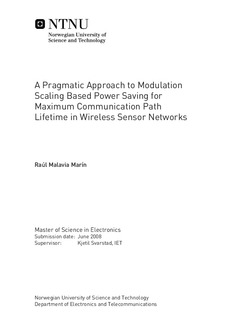A Pragmatic Approach to Modulation Scaling Based Power Saving for Maximum Communication Path Lifetime in Wireless Sensor Networks
Master thesis
Permanent lenke
http://hdl.handle.net/11250/2369141Utgivelsesdato
2008Metadata
Vis full innførselSamlinger
Sammendrag
The interest in Wireless Sensor Networks is rapidly increasing due to their interesting advantages related to cost, coverage and network deployment. They are present in civil applications and in most scenarios depend upon the batteries which are the exclusive power source for the tiny sensor nodes. The energy consumption is an important issue for research, and many interesting projects have been developed in several areas. They focus on topology topics, Medium Access Control or physical issues. Many projects aim at the physical layer where the node's power consumption is optimized through scaling the modulation scheme used in node communications. Results show that an optimal modulation scheme can lead to the minimum power consumption over the whole wireless sensor network. A usual simplification in research is to target individual paths and not take into account the whole network. However nodes may be part of several paths, and therefore nodes closer to the sinks may consume higher amounts of energy. This fact is the chief motivation of our research, where modulation scaling over the nodes with more energy is performed in order to increase the lifetime of the nodes having lower energy reserves. Simulation results showed typical values of path lifetime expectancy of 50 to 120 percent higher than comparable power-aware methods.
